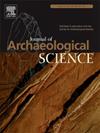三万五千年前西非有开采赭石的证据
IF 2.6
1区 地球科学
Q1 ANTHROPOLOGY
引用次数: 0
摘要
尽管对西非晚更新世的研究有了新的推动力,但对该地区中石器时代的行为范围知之甚少。然而,中石器时代石器技术的多样性证明了显著的行为和人口动态,其特征是创新和适应性。在这里,我们首次对西非的赭石遗骸进行了深入分析。来自塞内加尔东部Toumboura III遗址的新数据,时间在40±3至30±3 ka之间,表明赭石碎片的使用是偶尔和专门的赭石粉碎活动的一部分,可能专门用于生产粉末,以及使用赭石棒。赭石碎片在宏观和微观水平上进行了研究,虽然这些富含铁的物质可能在没有人为干预的情况下积聚在沉积物中,但另一组重要的赭石碎片被发现可能是在原位加工的。这些碎片上的撞击痕迹并不像人类剥削的痕迹那么明显。然而,它们不能用自然现象来解释。这些遗骸可能是塞内加尔开采赭石的最早证据。它们可能为研究西非中石器时代的象征行为开辟了新的视角。它们表明,人类在这一地区的全部行为还远远没有被捕捉到。本文章由计算机程序翻译,如有差异,请以英文原文为准。
Evidence for discrete ochre exploitation 35,000 years ago in West Africa
Despite new impetus for Late Pleistocene research in West Africa, little is known about the range of Middle Stone Age behaviours in this region. Yet, the multiplicity of Middle Stone Age lithic technologies testifies to significant behavioural and demographic dynamics, marked by innovation and adaptability. Here, we present the first in-depth analysis of ochre remains in West Africa. New data from Toumboura III site, eastern Senegal, dated between 40 ± 3 and 30 ± 3 ka, point towards the use of ochre pieces as part of an occasional and specialized ochre crushing activity, probably dedicated to the production of powders, as well as the use of ochre sticks. Ochre pieces were studied at both macro and microscopic levels and while some of this iron-rich material likely accumulated in the deposits without anthropogenic intervention, another significant set of ochre pieces was found that was likely processed in situ. The impact scars on the pieces are not as striking as grinding traces for evidencing human exploitation. Nonetheless, they cannot be explained by natural phenomena. These remains could represent the earliest known evidence of ochre exploitation in Senegal. They potentially open new perspectives on symbolic behaviours in the Middle Stone Age of West Africa. They show that the full range of human behaviours in this region is yet far from being captured.
求助全文
通过发布文献求助,成功后即可免费获取论文全文。
去求助
来源期刊

Journal of Archaeological Science
地学-地球科学综合
CiteScore
6.10
自引率
7.10%
发文量
112
审稿时长
49 days
期刊介绍:
The Journal of Archaeological Science is aimed at archaeologists and scientists with particular interests in advancing the development and application of scientific techniques and methodologies to all areas of archaeology. This established monthly journal publishes focus articles, original research papers and major review articles, of wide archaeological significance. The journal provides an international forum for archaeologists and scientists from widely different scientific backgrounds who share a common interest in developing and applying scientific methods to inform major debates through improving the quality and reliability of scientific information derived from archaeological research.
 求助内容:
求助内容: 应助结果提醒方式:
应助结果提醒方式:


